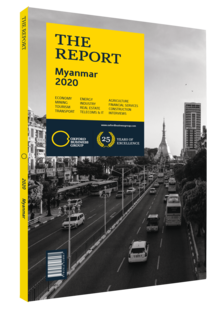Growing international trade encourages investment in Myanmar's maritime infrastructure
Myanmar has a total of nine coastal ports and more than 400 inland river ports. Its location close to major shipping routes and some of the world’s emerging economic powers, combined with a growing openness to international trade, could see the country unlock much-needed investment in maritime infrastructure in the decade leading to 2030.
High Potential
Myanmar’s coastal ports are at Sittwe, Kyaukphyu, Thandwe, Pathein, Yangon, Mawlamyine, Dawei, Myeik and Kawthaung. Although the Myanma Port Authority manages the ports, most cargo terminals are privately run. In general, facilities at inland ports are rudimentary, with some lacking proper piers or jetties. Workers must occasionally wade through knee-deep water and manually place cargo on board. In summer, when the river is shallow, transporters must cut cargo loads by half. It is due to such conditions that inland water transport accounts for less than 10% of freight that moves between ports in Myanmar. However, development of the Mandalay Port could change that. The new port will be equipped with container storage, cargo warehouses, pier bridges, approach bridges and cargo-handling machinery. Once complete, Mandalay Port will have a capacity of 200,000 tonnes of cargo.
In terms of deepwater ports, Myanmar’s government has signed a deal with the China International Trust and Investment Corporation for the $1.3bn construction of the first phase of a new port in Kyaukphyu. The port will have a terminal with two berths and will be 70% financed by China. It will enable ships to bypass the Strait of Malacca, significantly reducing costs.
Regional Interests
India, meanwhile, is developing the Sittwe Port. New Delhi sees this multi-modal transit project as a cornerstone of its strategic priority to link its eastern city of Kolkata with the north-eastern state of Mizoram via Myanmar. Demonstrating the project’s importance to India, in February 2019 India’s security forces conducted a joint military operation with their Myanmar counterparts against insurgents that posed a threat to the operation. As of November 2019 India had constructed an inland water transport jetty at Sittwe and a container terminal is expected to be developed soon. Meanwhile, Thailand and Japan have been assisting in the development of a 196-sq-km deepwater port in Dawei, in Tanintharyi Region, during 2019.
Yangon
None of this, however, is likely to replace the primacy of the Yangon Port, which currently handles 90% of Myanmar’s international cargo. In FY 2018/19 some 2270 vessels docked at Yangon Port, which handled over 36m tonnes of cargo between 2016 and 2019. “Yangon Port will retain its strong position for the foreseeable future,” Daw Su Yee, director at maritime logistics services company Thuriya Sandar Win, told OBG. “It is an expensive port to operate, however, as its location on a river requires frequent dredging in order to clear silt,” she said. The Yangon Port is accessible to vessels 167-metres long, with 9 metres of draft and a cargo volume of up to 20,000 deadweight tonnage (DWT) and the Thilawa Port is accessible to vessels up to 200-metres long, with 9m of draft and 40,000 DWT.
In 2019 Indian conglomerate Adani received in-principle approval to construct a new international port terminal at Ahlone, near Yangon. The $290m port terminal, which is expected to become operational by 2021, will be able to handle 800,000 of twenty-foot equivalent units (TEUs) of cargo per annum. Myanmar’s total container throughput in 2019 was 1.2m TEUs, however, this figure is expected to double in the coming years.
The single-most significant driver for port development could be the Regional Comprehensive Economic Partnership (RCEP), the world’s largest multilateral trade pact, which Myanmar is expected to sign in early 2020. Trade between Myanmar and RCEP countries is anticipated to grow by 8-12% annually between 2018 and 2022. Furthermore, the National Transport Master Plan, the government’s long-term blueprint for sector development, estimates that cargo movement in and out of Myanmar will reach around 312m tonnes by 2030.
You have reached the limit of premium articles you can view for free.
Choose from the options below to purchase print or digital editions of our Reports. You can also purchase a website subscription giving you unlimited access to all of our Reports online for 12 months.
If you have already purchased this Report or have a website subscription, please login to continue.

